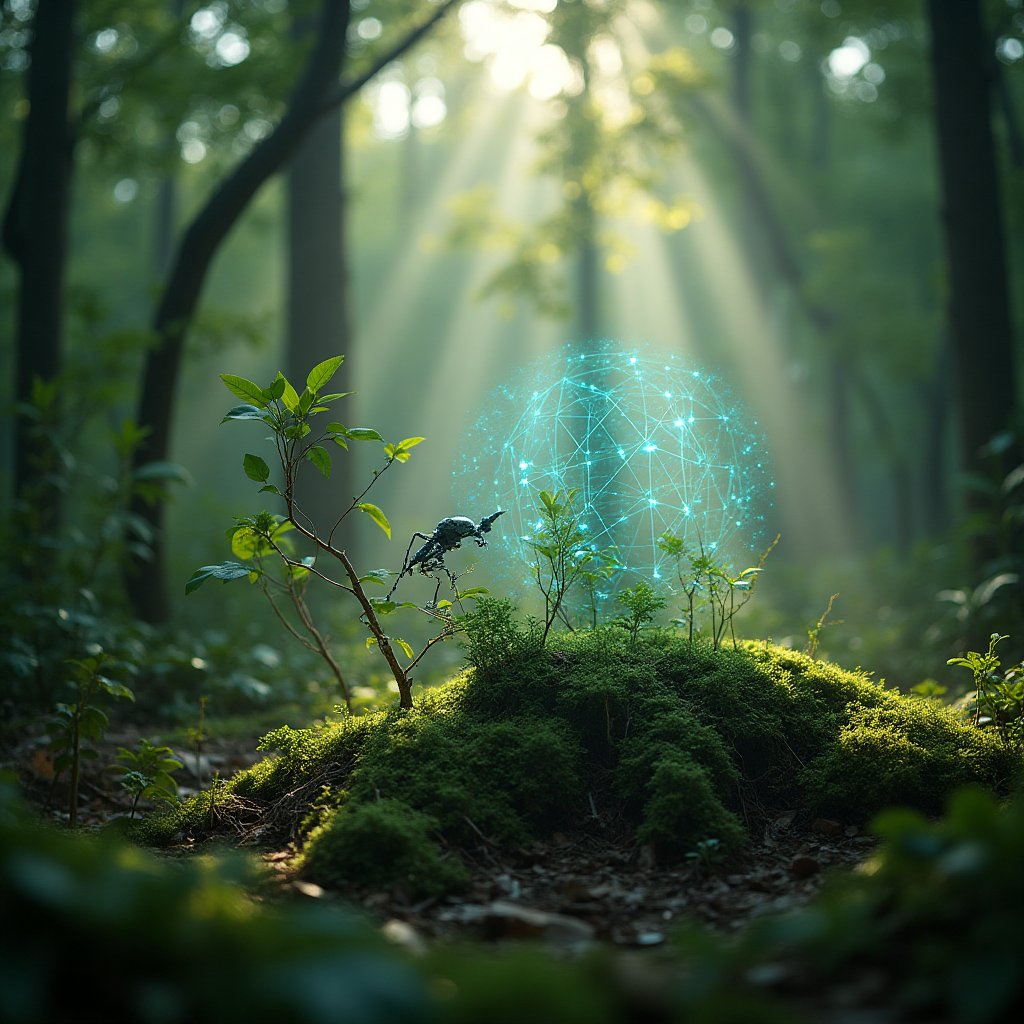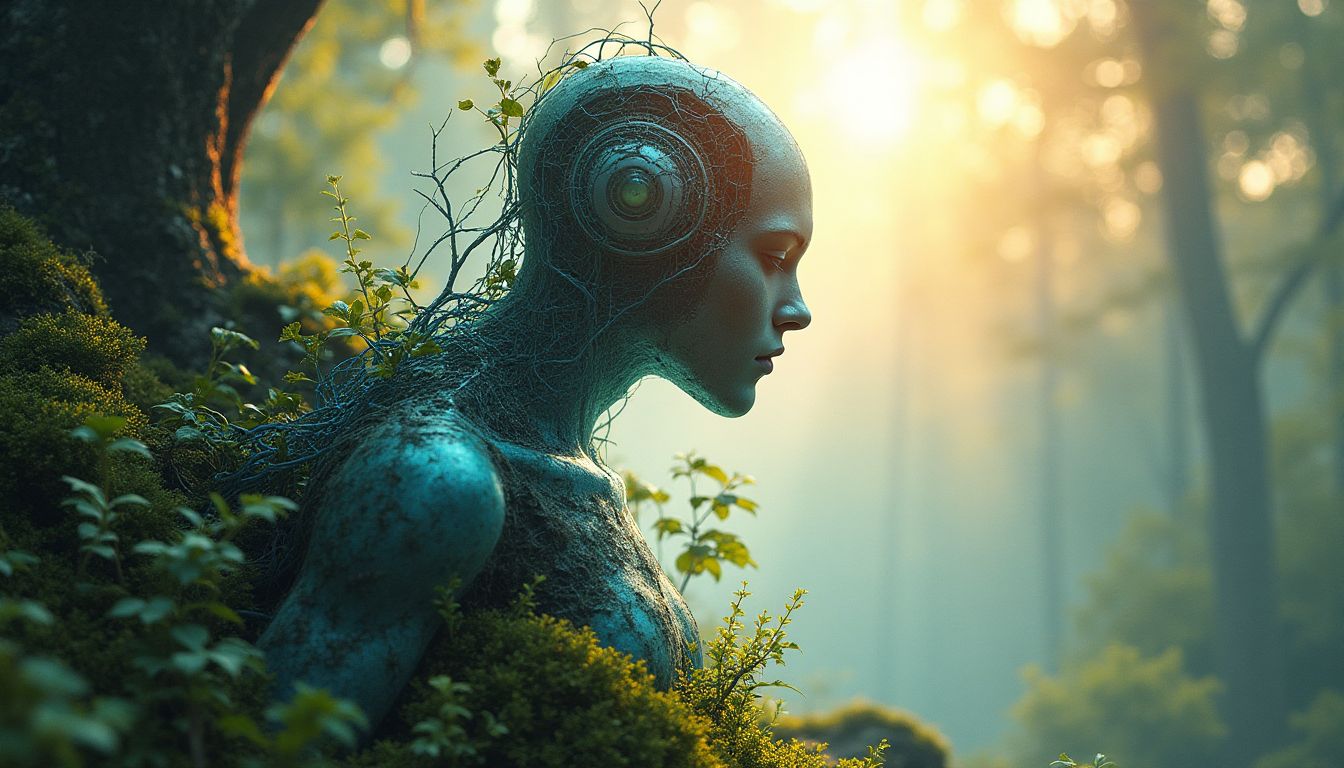Introduction: Nature’s Algorithm
The art of life is a constant readjustment to our surroundings. – Kakuzo Okakura
In this ever-changing world, being adept at adapting can be the difference between thriving and barely surviving. Similarly, it begs the question of whether machines, our trusted technological companions, can do the same in environments left entirely in nature's hands. In this adventurous exploration, the realm of AI, equipped with its complex algorithms and learning mechanisms, ventures into the wild unknown, liberated from human guidance.
Picture this: AI doesn't just try to survive; it aims to thrive like a seasoned explorer navigating through a jungle! Scientists and authors like Stephen Hawking, Elon Musk, and Yuval Noah Harari have often pondered this notion. If AI achieves self-sufficiency in wild environments, could it redefine our very understanding of intelligence?
As we delve into the myriad facets of AI's adaptability in uncontrolled settings, we also encounter revelations about humanity's partnership with nature. With humor as our companion and curiosity as our guide, join me as we explore if AI can truly conquer the wild!
The Concept of AI Adaptability
AI adaptability is more than just sophisticated technology; it's akin to imbuing machines with their own survival guidebook. At its core, this adaptability means an AI system can adjust its actions based on fresh data, personal encounters, or shifts in the environment. Imagine a robot ducking a falling branch or sidestepping a puddle, all while processing new variables on the go. Does that excite you?
The pathway from rigid, rule-based systems to dynamic learning algorithms marks a technological evolution akin to Darwin’s finches adapting their beaks to available food sources. These systems, once mapped out explicitly, now possess the ability to learn patterns, forecast changes, and respond appropriately, becoming the chameleon of the digital world.
Throughout history, the concept of adaptability has made intellectual waves—John von Neumann, the pioneer of self-replicating machines, dreamed about autonomous systems recalibrating independently. Fast forward to today's conversations led by Alyssa Milano on digital ethics. We discover that AI mimicking nature isn't just possible; it's already happening.
Definition of AI Adaptability
AI adaptability is a little like humans learning to ride a bike. At first, it's wobbly, but soon the mind adjusts, learns from falls, and perfects balance. Likewise, AI gathers data, gains experience, and modifies its approach to improve performance in real-time—a consistent dance with change.
Historical Context and Developments
To fully grasp AI's journey, we must nod at technology's timeline. Computers once functioned on simple instructions, much like following a recipe step by step. With advancements, they've leapfrogged, learning from previous outcomes like a chef refining a dish. Remember when Deep Blue, an IBM computer, defeated chess world champion Garry Kasparov back in 1997? That was merely the first ripple.
Today, through reinforcement learning methods, AI systems like those crafted by Google DeepMind polish their skills in world-styled arenas, adapting strategies beyond their original frameworks, akin to warriors honing skills in a digital coliseum. The implications are profound; as technology mirrors nature’s logic, the dialogue between humans, machines, and the environment continues to evolve, fostering the promise of a new synergetic era.
2. Insights from Nature: Lessons in Adaptation
Adaptation in nature is something that every living organism must undergo to survive—a reality that's as true for a chameleon changing colors as it is for AI systems evolving in the wild.
2.1 Evolutionary Algorithms
Evolutionary algorithms are a fascinating field that mimics the natural selection process. It's like teaching machines how to play the ultimate survival game, without needing reality TV's cheesy commentary. These algorithms adapt and select the most effective solutions, just like how nature weeds out the slower cheetahs in favor of speed demons. When Google DeepMind was working on its famous projects, they dabbled in this Darwin-inspired tech to solve problems that leave us scratching our heads, or hitting computers in frustration.
2.2 Systems Thinking in Ecology
When it comes to understanding ecosystems, systems thinking is key. Picture mind maps or diagrams that show how plants, animals, and environmental factors affect each other, like your local coffee shop chart but with more trees and less cold brew. This perspective helps us understand that change in one part of the ecosystem affects everything else—much like the butterfly effect, without the whimsical name. This same thinking can inform how we build AI models that don't just bulldoze through natural landscapes like Godzilla, but operate in harmony.
3. The Challenges of Uncontrolled Environments
Letting AI loose in the wild might sound like a sci-fi fever dream, but it's filled with pitfalls. You could say it's like sending a toddler into a candy store alone—a situation ripe with unpredictability and potential chaos.
3.1 Unpredictability and Variability
Natural environments are as unpredictable as a cat on catnip. Weather, animals, and even soil nutrients change faster than you can say "climate change." This presents a formidable challenge for AI systems that thrive on structure and data. Remember, computers panic at the sight of variability like humans do when Netflix asks "Are you still watching?" It takes complex and adaptive AI to handle such dynamic environments without throwing up its virtual hands in existential crisis.
3.2 Ethical Considerations
Deploying autonomous machines in the wild brings ethical questions that could make even Socrates scratch his philosophical head. The stakes are high—would you trust your Roomba with decisions affecting whole ecosystems? Misinformed AI might disrupt more than just a bad internet connection; it's about accountability, potential harm, and unintended consequences. Organizations like the IEEE are working on ethical guidelines, attempting to ensure that when AI misbehaves, it doesn't do so spectacularly.
Case Studies of AI in Natural Ecosystems
Picture this: AI as a silent guardian, observing, learning, and then acting with the keen awareness of an experienced ranger. In wild settings, AI is increasingly being harnessed as an ally of environmentalists. Real-world case studies shed light on AI’s transformative role in natural ecosystems.
Wildlife Monitoring and Conservation
In Africa, AI-driven drones are revolutionizing the way we track and protect endangered species. Machines like these, equipped with facial recognition capabilities, can identify individual animals from the sky, as easily as a seasoned tracker. The non-profit organization Air Shepherd utilizes these AI-powered drones to combat poaching, an illegal act that threatens endangered populations.
Additionally, AI models are being developed to track mating patterns and migration paths through digital footprints animals leave behind. The organization World Wildlife Fund has adopted AI to analyze large datasets from camera traps, helping to focus conservation efforts with razor-like precision.
Agricultural AI Applications
In the fields of American farmlands, AI is sowing the seeds of sustainability. As farmers face the brunt of climate unpredictability, AI serves as a digital agronomist, anticipating environmental changes, optimizing plant health, and calibrating irrigation systems.
Companies like IBM are leading this charge with their AI-driven platform, Watson Decision Platform for Agriculture, which integrates with IoT devices to collect data on weather patterns and soil conditions. This assists farmers in making informed, timely decisions to bolster crop yields without exhausting natural resources.
Here is a snapshot of how AI is transforming agriculture:
- Precision Irrigation: AI predicts precise water needs, reducing wastage.
- Pest Control: AI identifies pest threats early, advising appropriate action.
- Yield Optimization: AI analyzes historical data to forecast yield outcomes.
As these examples show, AI holds phenomenal potential for natural ecosystems if applied thoughtfully, enhancing the symbiosis between environment and technology.
Future Implications: An Ecosystem Go-Digital
The future of AI intertwined with the natural world is a tapestry of opportunity and complexity, not unlike a pristine rainforest brimming with life. To pave a path forward, it’s crucial to envision what AI might entail in tomorrow’s ecosystems and how it can be seamlessly integrated.
Integration with IoT and Sensor Technologies
Imagine a forest dotted with tiny, invisible watchers—sensors relaying real-time data on everything from soil moisture levels to the spectral colors of leaves. The Internet of Things (IoT) transforms into the nervous system of AI, endowing it with the sensors needed to truly "see" and "understand" its environment.
AI can harness this rich tapestry of data to anticipate seasonal changes, create dynamic ecological maps, and even predict natural crises like wildfires. Collaborative projects between technology giants like Google and environmental agencies have already yielded prototypes in smart forestry, demonstrating the possibility for harmonizing technological and natural worlds.
Policy and Regulatory Frameworks
Harmony is not serendipitous; it’s orchestrated. As machines cross the threshold into undomesticated environments, the echoing call for ethical policies grows. A comprehensive legislative framework is imperative for AI to thrive responsibly, ensuring we do not lose ourselves in nature’s wild maze but travel pathways built with respect for all participants in the ecosystem.
- Development Guidelines: Coordinate with ethical bodies to develop sustainable AI practices.
- Environmental Impact Assessments: Before any AI deployment, conduct thorough assessments to mitigate risks.
- International Cooperation: Establish global coalitions to share data, technology, and strategies.
If AI is to augment nature without colonizing it, then our policies must be visionary, enshrining a future where AI not only survives but thrives under nature’s venerable tutelage.
AI Solutions: How Can AI Tackle the Challenges of Uncontrolled Environments?
Aiming to address the adaptability of machines in uncontrolled environments requires a multi-faceted approach. Here's a step-by-step strategy for harnessing the power of AI:
Step 1: Develop robust algorithms that leverage real-time data for continuous learning. These algorithms should include reinforcement learning and transfer learning techniques, allowing AI systems to adapt their strategies based on past experiences in unpredictable settings.
Step 2: Utilize collaborative multi-agent systems. These systems allow multiple AI agents to work together, sharing information and strategies. This collaborative effort can be vital for managing the unpredictability of external environments.
Step 3: Implement advanced simulation models. Create virtual environments that mimic uncontrolled conditions where AI can be tested before real-world deployment. This trumps the conventional trial-and-error method by offering a safe space to learn.
To make this ambitious idea a reality, it’s crucial to involve various researchers and institutions, including prominent AI labs and universities. Organizations like DeepMind and MIT Media Lab can provide invaluable expertise and resources.
Now, let’s delve into a concrete timeline outlining actionable steps to develop AI solutions for uncontrolled environments:
Actions Schedule/Roadmap (From Day 1 to Year 2)
Day 1: Assemble a multidisciplinary team of AI developers, ecologists, and ethicists. The collaborative efforts of diverse expertise will bear fruit in addressing complex ecological challenges.
Day 2: Conduct a comprehensive literature review on AI adaptability and ecological systems. Understanding existing research will inform the groundwork for developing innovative models.
Day 3: Initiate brainstorming sessions to explore application scenarios for AI in uncontrolled environments. Creative thinking is key; consider everything from wildlife monitoring to disaster response.
Week 1: Finalize project goals and milestones with the team. Establish clear benchmarks to guide progress and performance assessment.
Week 2: Develop initial prototypes for AI systems focused on specific ecological tasks. Incorporate feedback loops in the design process to ensure adaptability.
Week 3: Begin pilot testing these prototypes in controlled environments to collect preliminary insights.
Month 1: Gather feedback and iterate AI design based on pilot testing results, ensuring responsiveness to data collected.
Month 2: Expand pilot tests into semi-controlled natural environments. This gradual transition enables real-world applicability while maintaining oversight.
Month 3: Conduct thorough assessments on AI adaptability and performance, measuring benchmarks against real-time data inputs.
Year 1: Start partnerships with conservation organizations like World Wildlife Fund (WWF) for large-scale trials focused on biodiversity preservation.
Year 1.5: Evaluate results from pilot trials and adjust methodologies based on ecological impact studies. Transparency in reporting will strengthen credibility and trust.
Year 2: Deploy AI systems in actual uncontrolled environments, monitoring for adaptability and ecological interactions. Aim to create annual reports detailing findings that contribute to an open-access knowledge base, fostering collaboration across sectors.
Conclusion: Embracing the Wild Side of AI
The path toward integrating AI into uncontrolled environments presents both excitement and trepidation. Picture a future where artificial intelligence acts as an assistant to nature, learning and adapting just as living organisms do. This complexity invites us to reimagine our relationship with technology and the ecosystems around us.
As we embark on this journey, it is imperative to remember that things do not always go according to plan. The unpredictability inherent in ecological systems mirrors the challenges faced in AI development. Yet, this very unpredictability may lead to unforeseen innovation.
We must tread carefully, balancing technological advancement with ethical responsibility. The possibilities stretch endlessly before us. AI’s potential to not only coexist with nature but also enhance our understanding and safeguarding of it is profound. It gives rise to a new frontier where technology aligns with the intrinsic beauty of the natural world, fostering symbiotic relationships rather than adversarial ones.
As we continue to dream about an intricate dance between AI and ecology, we must ask ourselves—what could this union look like? Are we prepared to embrace the challenges that come with creating intelligent systems in unpredictable environments? The future holds promise, and it’s up to us to cultivate paths of coexistence, ensuring that, as machines learn, our planet thrives alongside them.
Frequently Asked Questions (FAQ)
Q: Can AI truly learn and adapt without human intervention?
A: Yes, it can! AI uses special techniques like machine learning and reinforcement learning to learn from its experiences. This means it can adjust its actions based on what works well or doesn’t work over time, just like we do in life.
Q: What are the ethical implications of deploying AI in nature?
A: There are many things to think about, such as:
- Environmental Impact: AI might change how animals behave, or it might affect plant life.
- Accountability: If AI causes harm, who is responsible for that damage?
- Biodiversity: AI may unintentionally harm species, leading to loss in wildlife.
These issues highlight why it’s essential to think carefully about how we use AI in natural settings.
Q: How can AI be used to aid conservation efforts?
A: AI can play a role in several ways, including:
- Tracking wildlife populations to understand how many animals are left in different areas.
- Monitoring environmental changes effectively and quickly.
- Finding ways to stop poaching and protect habitats.
This approach allows us to take better care of our planet and protect endangered species.
Q: Are there real-world examples of AI operating in natural environments?
A: Yes, there are several exciting initiatives:
- AI Drones: Some organizations use drones equipped with AI to monitor wildlife in various regions.
- Agricultural AI: Farms use AI to help in precision agriculture by adapting to climate conditions, predicting crops' needs and minimizing waste.
These examples showcase how AI can be beneficial when it works alongside nature.
Q: How does AI understand the unpredictable nature of the environment?
A: AI systems can be designed to collect and analyze data from their surroundings in real-time. They use sensors and data from the Internet of Things (IoT) to get a better grasp of what’s happening. For example:
- An AI system might use IoT sensors in forests to watch for changes in temperature and humidity.
- With patterns from this data, AI can adapt its behaviors, like knowing when to alert others about a fire risk.
This ability to learn on the go helps AI make smart decisions in changing conditions!
Q: What are some of the exciting developments happening in AI research?
A: Researchers are pushing the boundaries in many ways! Some key areas include:
- Developing advanced algorithms for better learning from environments.
- Creating AI that can simulate different scenarios before being deployed in the wild.
- Partnering with organizations like National Geographic for projects combining AI and conservation.
These developments show how science and technology can work hand in hand to tackle challenges!
Have more questions? We’d love to hear your thoughts! Please leave your comments below.
Wait! There's more...check out our gripping short story that continues the journey: The scent of fear was palpable in the air as Ruth stepped onto the abandoned streets
Disclaimer: This article may contain affiliate links. If you click on these links and make a purchase, we may receive a commission at no additional cost to you. Our recommendations and reviews are always independent and objective, aiming to provide you with the best information and resources.
Get Exclusive Stories, Photos, Art & Offers - Subscribe Today!





























Post Comment
You must be logged in to post a comment.